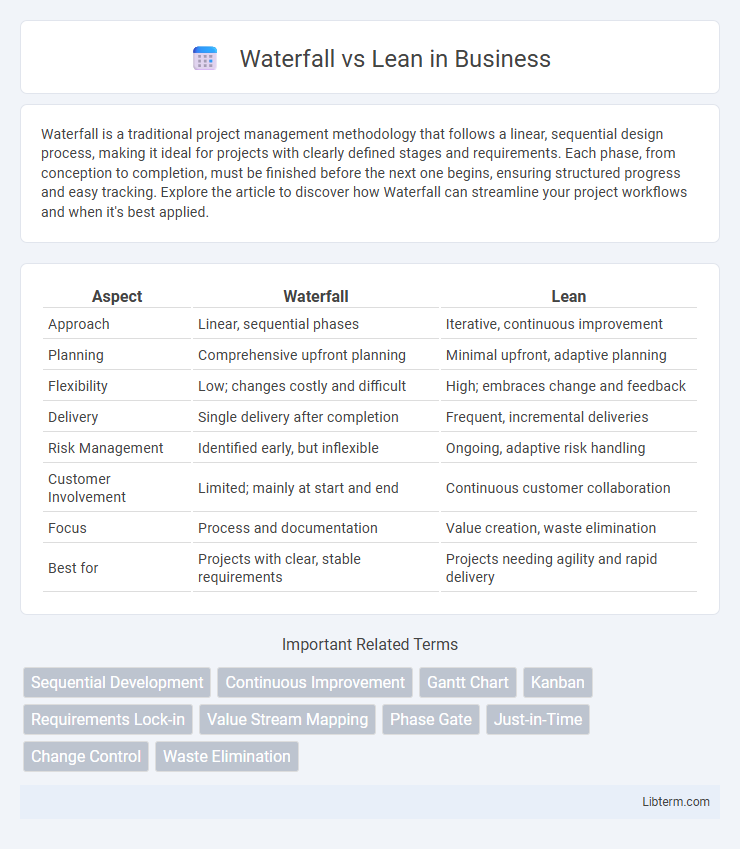Waterfall is a traditional project management methodology that follows a linear, sequential design process, making it ideal for projects with clearly defined stages and requirements. Each phase, from conception to completion, must be finished before the next one begins, ensuring structured progress and easy tracking. Explore the article to discover how Waterfall can streamline your project workflows and when it's best applied.
Table of Comparison
| Aspect | Waterfall | Lean |
|---|---|---|
| Approach | Linear, sequential phases | Iterative, continuous improvement |
| Planning | Comprehensive upfront planning | Minimal upfront, adaptive planning |
| Flexibility | Low; changes costly and difficult | High; embraces change and feedback |
| Delivery | Single delivery after completion | Frequent, incremental deliveries |
| Risk Management | Identified early, but inflexible | Ongoing, adaptive risk handling |
| Customer Involvement | Limited; mainly at start and end | Continuous customer collaboration |
| Focus | Process and documentation | Value creation, waste elimination |
| Best for | Projects with clear, stable requirements | Projects needing agility and rapid delivery |
Introduction to Waterfall and Lean Methodologies
Waterfall methodology is a linear and sequential approach to project management, where each phase must be completed before the next begins, making it ideal for projects with well-defined requirements. Lean methodology emphasizes eliminating waste, optimizing workflows, and continuous improvement, focusing on delivering maximum value to customers with minimal resources. Both methodologies aim to enhance efficiency but differ significantly in flexibility, adaptability, and stakeholder involvement throughout the project lifecycle.
Core Principles of Waterfall
Waterfall methodology is defined by its linear and sequential approach, emphasizing distinct phases such as requirements gathering, design, implementation, testing, and maintenance, each completed before the next begins. This model prioritizes thorough documentation and upfront planning to minimize changes during development, ensuring predictability and clear milestones. Core principles include fixed scope, schedule, and budget, making Waterfall well-suited for projects with well-defined requirements and low uncertainty.
Core Principles of Lean
Lean methodology centers on eliminating waste, continuous improvement (kaizen), and delivering maximum value to the customer through iterative cycles and cross-functional collaboration. In contrast to Waterfall's linear and sequential approach, Lean promotes flexibility, responsiveness, and empowering teams to adapt quickly to changing requirements. Key Lean principles include just-in-time production, respect for people, and optimizing the whole process rather than individual tasks.
Key Differences Between Waterfall and Lean
Waterfall is a linear, sequential project management approach emphasizing fixed phases and thorough documentation, while Lean focuses on maximizing value through continuous improvement and eliminating waste. Waterfall projects typically have clear, upfront requirements and predetermined timelines, whereas Lean adapts to change rapidly with iterative development cycles. The key difference lies in Waterfall's rigid structure compared to Lean's flexibility and emphasis on efficiency and customer feedback.
Project Planning: Waterfall vs Lean
Waterfall project planning follows a linear, sequential approach with clearly defined phases and fixed timelines, ensuring strict documentation and task completion before moving forward. Lean project planning emphasizes flexibility, continuous feedback, and iterative development, reducing waste and adapting quickly to changing requirements. While Waterfall is ideal for projects with well-defined scopes, Lean excels in environments demanding rapid innovation and ongoing process improvement.
Flexibility and Adaptability Comparison
Waterfall methodology follows a linear, sequential approach with fixed phases, limiting flexibility and making it challenging to adapt to changes once the project is underway. Lean methodology emphasizes continuous improvement, iterative development, and rapid feedback, fostering higher adaptability to evolving customer needs and market conditions. Teams using Lean can pivot quickly based on real-time insights, whereas Waterfall projects often face delays and increased costs when attempting to accommodate new requirements.
Team Collaboration in Waterfall vs Lean
Waterfall methodology follows a linear, phased approach where team collaboration is often sequential and role-specific, limiting real-time interaction. Lean emphasizes continuous team collaboration through iterative cycles and feedback loops, fostering cross-functional communication and adaptive problem-solving. This collaborative environment in Lean enhances agility and responsiveness compared to the structured and siloed collaboration typical in Waterfall.
Risk Management Approaches
Waterfall employs a structured risk management approach with detailed upfront risk identification and mitigation plans, focusing on minimizing uncertainties early in the project lifecycle. Lean emphasizes continuous risk assessment through iterative cycles, promoting quick identification and resolution of issues to avoid waste and enhance value delivery. Combining Waterfall's predictive risk controls with Lean's adaptive risk responses can improve overall project resilience.
Suitability for Various Project Types
Waterfall methodology suits projects with clearly defined requirements and predictable outcomes, such as construction or manufacturing, where sequential phases ensure thorough planning and execution. Lean methodology excels in dynamic environments like software development or startups, promoting flexibility, continuous improvement, and waste minimization to adapt quickly to changing demands. Choosing between Waterfall and Lean depends on project complexity, requirement stability, and the need for iterative feedback.
Choosing the Right Methodology for Your Project
Selecting the optimal project management methodology depends on project complexity, team structure, and flexibility needs. Waterfall suits projects with well-defined requirements and sequential phases, ensuring thorough documentation and clear milestones. Lean excels in environments prioritizing waste reduction, continuous improvement, and rapid iterations, making it ideal for dynamic projects requiring adaptive planning and customer feedback integration.
Waterfall Infographic

 libterm.com
libterm.com